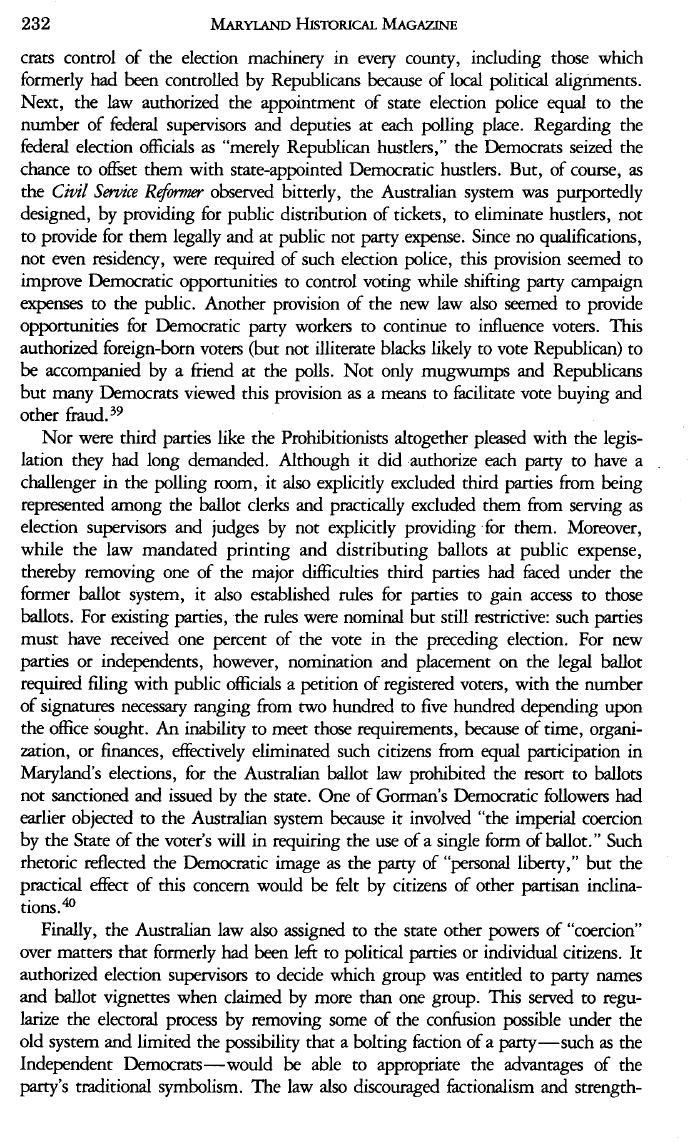|
232 MARYLAND HISTORICAL MAGAZINE
crats control of the election machinery in every county, including those
which
formerly had been controlled by Republicans because of local political
alignments.
Next, the law authorized the appointment of state election police equal to
the
number of federal supervisors and deputies at each polling place. Regarding
the
federal election officials as "merely Republican hustlers," the Democrats
seized the
chance to offset them with state-appointed Democratic hustlers. But, of
course, as
the Civil Service Reformer observed bitterly, the Australian system was
purportedly
designed, by providing for public distribution of tickets, to eliminate
hustlers, not
to provide for them legally and at public not party expense. Since no
qualifications,
not even residency, were required of such election police, this provision
seemed to
improve Democratic opportunities to control voting while shifting party
campaign
expenses to the public. Another provision of the new law also seemed to
provide
opportunities for Democratic party workers to continue to influence voters.
This
authorized foreign-born voters (but not illiterate blacks likely to vote
Republican) to
be accompanied by a friend at the polls. Not only mugwumps and Republicans
but many Democrats viewed this provision as a means to facilitate vote
buying and
other fraud.39
Nor were third parties like the Prohibitionists altogether pleased with the
legis-
lation they had long demanded. Although it did authorize each party to have
a
challenger in the polling room, it also explicitly excluded third parties
from being
represented among the ballot clerks and practically excluded them from
serving as
election supervisors and judges by not explicitly providing for them.
Moreover,
while the law mandated printing and distributing ballots at public expense,
thereby removing one of the major difficulties third parties had faced
under the
former ballot system, it also established rules for parties to gain access
to those
ballots. For existing parties, the rules were nominal but still
restrictive: such parties
must have received one percent of the vote in the preceding election. For
new
parties or independents, however, nomination and placement on the legal
ballot
required filing with public officials a petition of registered voters, with
the number
of signatures necessary ranging from two hundred to five hundred depending
upon
the office sought. An inability to meet those requirements, because of
time, organi-
zation, or finances, effectively eliminated such citizens from equal
participation in
Maryland's elections, for the Australian ballot law prohibited the resort
to ballots
not sanctioned and issued by the state. One of Gorman's Democratic
followers had
earlier objected to the Australian system because it involved "the imperial
coercion
by the State of the voter's will in requiring the use of a single form of
ballot." Such
rhetoric reflected the Democratic image as the party of "personal liberty,"
but the
practical effect of this concern would be felt by citizens of other
partisan inclina-
tions. 4°
Finally, the Australian law also assigned to the state other powers of
"coercion"
over matters that formerly had been left to political patties or individual
citizens. It
authorized election supervisors to decide which group was entitled to party
names
and ballot vignettes when claimed by more than one group. This served to
regu-
larize the electoral process by removing some of the confusion possible
under the
old system and limited the possibility that a bolting faction of a
party-such as the
Independent Democrats-would be able to appropriate the advantages of the
party's traditional symbolism. The law also discouraged factionalism and
strength-
|

